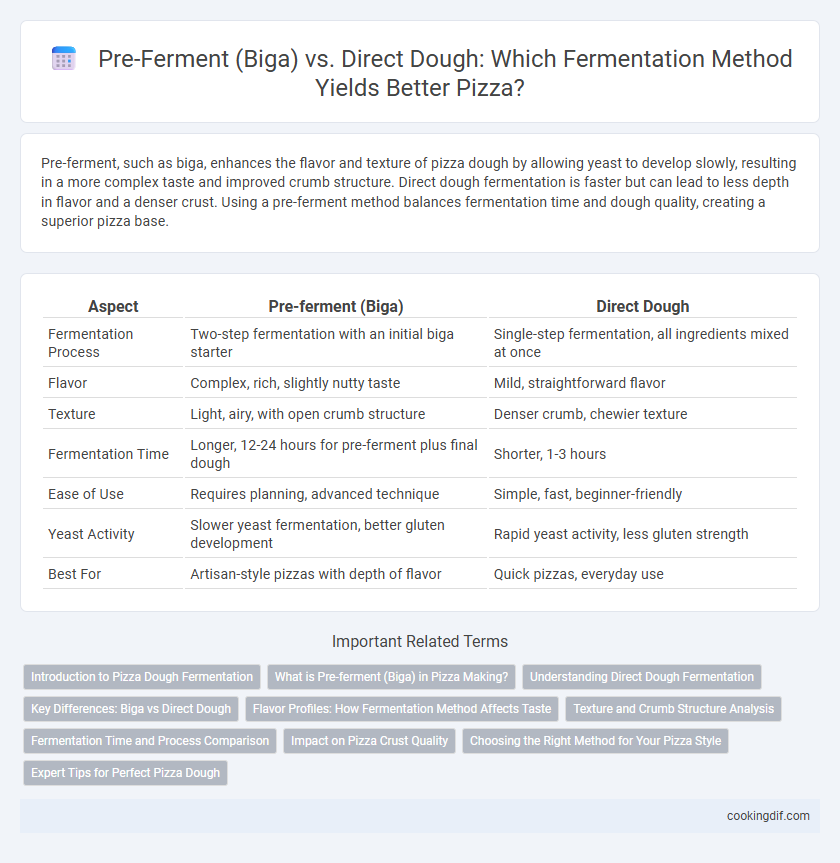Pre-ferment, such as biga, enhances the flavor and texture of pizza dough by allowing yeast to develop slowly, resulting in a more complex taste and improved crumb structure. Direct dough fermentation is faster but can lead to less depth in flavor and a denser crust. Using a pre-ferment method balances fermentation time and dough quality, creating a superior pizza base.
Table of Comparison
| Aspect | Pre-ferment (Biga) | Direct Dough |
|---|---|---|
| Fermentation Process | Two-step fermentation with an initial biga starter | Single-step fermentation, all ingredients mixed at once |
| Flavor | Complex, rich, slightly nutty taste | Mild, straightforward flavor |
| Texture | Light, airy, with open crumb structure | Denser crumb, chewier texture |
| Fermentation Time | Longer, 12-24 hours for pre-ferment plus final dough | Shorter, 1-3 hours |
| Ease of Use | Requires planning, advanced technique | Simple, fast, beginner-friendly |
| Yeast Activity | Slower yeast fermentation, better gluten development | Rapid yeast activity, less gluten strength |
| Best For | Artisan-style pizzas with depth of flavor | Quick pizzas, everyday use |
Introduction to Pizza Dough Fermentation
Pre-ferment, such as biga, enhances pizza dough by developing complex flavors and improving texture through a slow fermentation process, allowing yeast to work gradually. Direct dough fermentation involves mixing all ingredients at once, resulting in faster proofing but less flavor depth. Choosing between biga and direct dough methods impacts fermentation time, dough elasticity, and the final pizza crust's taste and chewiness.
What is Pre-ferment (Biga) in Pizza Making?
Pre-ferment, specifically biga, is a dough starter used in pizza making that consists of flour, water, and a small amount of yeast, fermented for 12 to 16 hours before mixing with the final dough ingredients. This method enhances flavor complexity, texture, and crust development by allowing natural yeast and bacteria to develop during fermentation. Biga improves dough strength and fermentation control, resulting in a pizza crust with better air pockets, chewiness, and a slightly tangy taste compared to direct dough fermentation.
Understanding Direct Dough Fermentation
Direct dough fermentation involves mixing all ingredients at once, allowing yeast to ferment the dough without a pre-ferment stage. This method shortens the overall preparation time and produces a softer crumb with a milder flavor compared to biga, which develops more complex aromas through extended fermentation. Understanding direct dough fermentation helps achieve a consistent texture and faster turnaround, ideal for quick pizza production.
Key Differences: Biga vs Direct Dough
Biga, a pre-ferment made by fermenting a portion of flour, water, and yeast before mixing the final dough, enhances flavor complexity and dough strength through extended fermentation. Direct dough method combines all ingredients at once, resulting in a shorter fermentation time but less developed taste and texture. Biga fermentation promotes better gas retention and crust structure, while direct dough offers convenience and faster preparation.
Flavor Profiles: How Fermentation Method Affects Taste
Pre-ferment methods like biga develop complex, tangy, and slightly nutty flavors due to extended fermentation, enhancing the dough's aroma and depth. Direct dough fermentation produces a more straightforward, yeasty flavor, resulting in a softer, less acidic crust. The choice between biga and direct dough significantly influences the pizza's taste, with biga offering richer, more nuanced flavor profiles favored in traditional Neapolitan-style pizzas.
Texture and Crumb Structure Analysis
Pre-ferment methods like biga enhance pizza dough texture by promoting gluten development and enzymatic activity, resulting in a more complex crumb structure with increased air retention and a chewy yet tender bite. Direct dough fermentation often produces a denser crumb with less pronounced flavor and a tighter texture due to shorter fermentation time and limited gluten network formation. Analyzing crumb structure through microscopy reveals that the pre-ferment dough displays larger, more irregular air pockets, contributing to a lighter mouthfeel and improved crust crispness.
Fermentation Time and Process Comparison
Pre-ferment methods like biga require longer fermentation times, typically 12 to 16 hours, allowing natural yeast and bacteria to develop complex flavors and improve dough texture. Direct dough fermentation is faster, usually completed within 1 to 3 hours, relying on higher yeast quantities but producing less nuanced flavor profiles. The biga process enhances dough strength and elasticity through slow enzymatic activity, while direct dough offers convenience with a simpler, rapid rise.
Impact on Pizza Crust Quality
Using pre-ferment like biga enhances pizza crust quality by developing complex flavors and improving dough texture through extended fermentation, resulting in a crispier, more aromatic crust. Direct dough fermentation offers faster preparation but often leads to a less nuanced taste and a softer, less chewy crust. Bakers seeking artisan-level pizza crust typically prefer biga for its superior gluten development and enhanced crust structure.
Choosing the Right Method for Your Pizza Style
Choosing the right fermentation method is crucial for achieving the desired texture and flavor in your pizza crust. Pre-ferment (biga) enhances complexity and chewiness by allowing yeast to develop slowly, making it ideal for traditional Neapolitan and artisan-style pizzas. Direct dough fermentation offers a quicker approach with a softer crumb, better suited for thin-crust or pan pizzas that require faster preparation without sacrificing quality.
Expert Tips for Perfect Pizza Dough
Pre-ferment methods like biga enhance dough flavor and texture by allowing yeast fermentation to develop more organic acids and alcohols, resulting in a complex, aromatic crust preferred by pizza experts. Direct dough fermentation offers speed and simplicity but often sacrifices depth of flavor and chewiness due to shorter yeast activity. For perfect pizza dough, using a biga pre-ferment with longer fermentation times maximizes gluten strength, dough extensibility, and the characteristic open crumb structure prized in traditional artisan pizzas.
Pre-ferment (biga) vs Direct dough for fermentation Infographic

 cookingdif.com
cookingdif.com